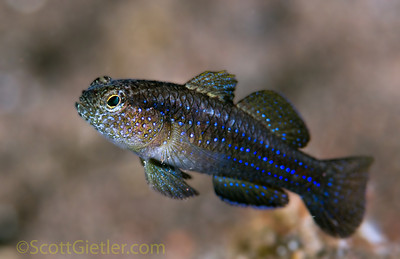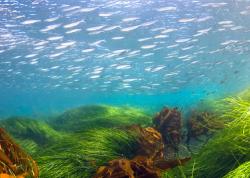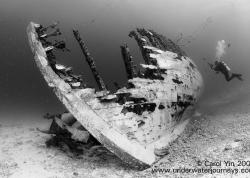Guide to Photographing Fish
Fish photography can be very challenging, but very rewarding. It's one of my favorite types of underwater photography. Don't give up easily - I hope some of these photography tips help you capture that perfect fish shot.
Use the right equipment & the best lens
A fast-focusing dSLR camera and a fast prime lens make fish photography much easier. Compact cameras can have difficulty focusing on fast-moving fish, so you will have to try harder.
Fish photography equipment tips
Use a fast, prime lens if shooting with a dSLR.
You should try to match the lens to the fish you want to photograph. The best lens depends on the size of the fish, and how close you can approach the fish.
Use 100mm or longer for small, fast or skittish fish. Compact users should zoom all the way in.
Use a 60mm or wider lens for larger fish. Zoom out as much as necessary. Here's an article on choosing underwater macro lenses. The sigma 17-70mm lens works well for larger fish. You can also use a macro lens behind a dome port.
A 1.4x teleconverter can be used to extend the range of your lens for skittish fish. This works especially well for small "darters" like gobies.
If the fish is large and doesn't move much, like a sea dragon, large frogfish or scorpionfish, don't be afraid to photograph it wide-angle - see the last photo on the page.
Schools of fish like to hang out in the corners of reefs, and in higher current areas. One diver even used a fish finder to find a great school to photograph!
Understand the fish's behavior
Knowing a fish's behavior is essential in getting excellent fish photos. This means asking questions where the fish is found, what time of day they are active, and how to best approach them.
Check your settings beforehand
Make sure your camera is set to the proper aperture and shutter speed. I start at F8, 1/125th on a dSLR, or F5.6, 1/200th on a compact.
Do a test shot on a stationary object to see if the background color is what you expect.
Have your camera on the fastest focus mode, usually continuous focus, spot focus mode. You want your camera to instantly shoot when you press the shutter.
Position your strobes before coming close to the fish. Watch out for areas that could give hot spots.
Spend time with the fish
Fish often will repeat behavior over time. Spend time watching a fish - does it repeat a pattern? Does it open its mouth, yawn, or have a mate? Watch a fish for several minutes before moving closer. Control your breathing as you approach a fish. Don't be afraid to spend a significant amount of time with a fish. Never chase a fish, let it get used to you and not view you as a threat.
Imagine the fish photo you want
Try to imagine the perfect photo of your fish. Is the depth of field small, or is the entire fish in focus? Always make sure the fish is facing you, and it's eyes are in focus. Will the fish look better with a blue background, or a black background? What kind of lighting will look best, even lighting or dramatic? One strobe will often give more dramatic lighting, which often works well with fish.
Be creative in your fish photography
Don't be afraid to try different creative underwater photography techniques, such as:
Small depth of field - using a large aperture (F2.8) and getting a blurred background
Using only 1 strobe, or a strobe without a diffuser
Using a slow shutter speed to show motion in the photo
Panning the camera to show motion
Zooming the lens while taking the photo
Using rear curtain sync and a slow shutter speed to show motion behind the fish, yet using a strobe to freeze it's motion
Thing about different underwater compositions, such as filling the frame, diagonal lines, etc.
For an artistic fish photo, photograph the fish eye, or a pattern on its body.
Go where no diver has gone before
Juvenile fish are beautiful, and often love habitats that other divers normally don't dive. Try shallow harbors at night, eelgrass, muck areas, piers & jetties like the Rapid Bay Jetty, etc for your fish photography.
Fish photography examples

Angelfish, Bali. F13, 1/320th, Nikon 105mm lens.

Blue-spotted goby, Bali. F11, 1/320th, 105mm lens. For gobies, approach carefully, stay low, watch your breathing, use a long lens. Try to find one that will allow a closer approach than the others, it takes repeated attempts.

Mosshead warbonnet, Channel Islands. F9, 1/125th

Flutemouth, Bali. F13, 1/125th. Take your time to get the right composition with a long fish like this, it's not easy.

Striped triggerfish, tulamben. f8, 1/125th, Nikon 60mm lens. This fish moves very fast and is very difficult to photograph - I tried for several dives with this species.

Kelp rockfish, taken with one strobe. F11, 1/80th, 60mm lens

Elegant pipefish photo, California. With stationary fish, work on composition.

Yellow boxfish, juvenile, Bali. F8, 1/160th, 60mm lens. With fish like these, you just have to be patient, they usually stay around the same area and will eventually get used to you.

Fish behavior photographs are great to get, but you really have to be on top of your game, and act fast, the moment usually doesn't last too long. Move very slowly to take the photo so you don't scare the fish.

Leafy sea dragon, Adelaide, with Tokina 10-17mm fisheye lens. don't be afraid to shoot "blind" if necessary by bringing the camera to the ground and just pressing the shutter without looking through the viewfinder, sometimes that is the only way to get close shots of fish like this. Use continuous focus mode so the camera does not have to wait to lock focus.
Fish portraits - by Jim Lyle
It's important to distinguish between "portraits" and "identification pictures" of fish. Identification images are normally taken side-on and include all of the fish's fins, body and head – kind of boring. Portraits are normally of the head and face of the fish, preferably showing action or character – much more interesting.
All of the basic rules, get close, shoot up, etc., apply when you are trying to take interesting pictures of fish. The main difficulty is with "get close." Do not chase fish! They will simply swim away and all you will have to show your friends are images of "fish butt." Fish tend to be very skittish around divers and a slow, methodical approach tends to work the best. Start taking pictures of your quarry from a distance, gradually decreasing the distance between you and the fish. Once you get close, move very slowly, in a non-threatening manner; make small bubbles (no sudden, large exhales); and take as many images as you can, from different angles. Think about the pictures and compose your shots. Use the rule of thirds, think magazine cover, shoot portrait rather than landscape, use negative space, shoot up, move the strobes around, and take as many pictures as you can in hopes of getting that one, magical "keeper."

Rockfish photo, photo taken by Jim Lyle. Taken in Catalina, California.

Baby sheephead at Catalina Island. F8, 1/250th, ISO 200. Fish portraits can be hard work, It took me dozens of dives to get this portrait, skittish fish usually are turning away or not at the right angle. I still wish I had a better background.

Some fish just enjoy smiling for a mug shot. Hawaii night dive. Nikon d80, 60mm lens, F10, 1/200th. The lighting emphasizes the fish.

Sailfin Blenny in Cozumel. Photo by Jim Lyle. Olympus E330, Zuiko 50mm lens + 1.4x teleconverter, F22, 1/100th, ISO 100. It takes patience, careful breathing, slow movement and good timing to get a nice fish pose like this. The framing is perfect, almost filling the frame but not touching the edges.
Further Reading

RECOMMENDED ARTICLES
SUPPORT THE UNDERWATER PHOTOGRAPHY GUIDE:
The Best Service & Prices on u/w Photo Gear
 Visit Bluewater Photo & Video for all your underwater photography and video gear. Click, or call the team at (310) 633-5052 for expert advice!
Visit Bluewater Photo & Video for all your underwater photography and video gear. Click, or call the team at (310) 633-5052 for expert advice!
The Best Pricing, Service & Expert Advice to Book your Dive Trips
 Bluewater Travel is your full-service scuba travel agency. Let our expert advisers plan and book your next dive vacation. Run by divers, for divers.
Bluewater Travel is your full-service scuba travel agency. Let our expert advisers plan and book your next dive vacation. Run by divers, for divers.































